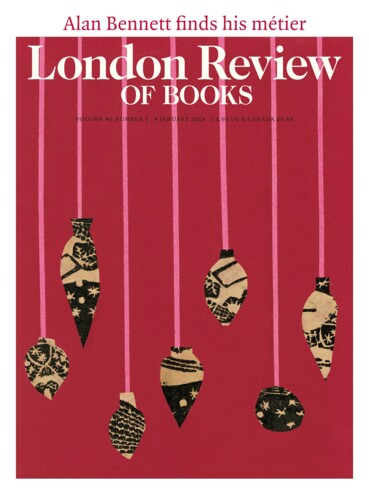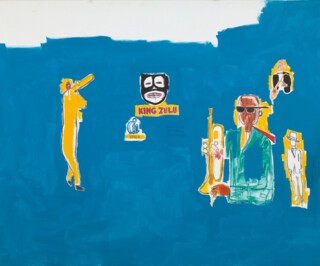It has been a good year, as these things go, for diversity in London’s galleries. Soul of a Nation, Queer British Art, Rose Wylie: Quack Quack and now Basquiat: Boom for Real have brought the work of queer, black, elderly and female artists into mainstream exhibitions. Of course, Jean-Michel Basquiat is a star – it happened more or less instantly after his move from street graffiti to painting in 1981 – yet the current retrospective at the Barbican (until 28 January) is the first show of his work in the UK for more than twenty years.
Most writers have found it impossible to resist the story of Basquiat’s fast life and early death (he died of a heroin overdose in 1988, aged 27). He is remembered as much for his astonishing beauty as for his work – the first thing that greets you at the Barbican is Tamra Davis’s 1985 footage of him painting and dancing, blown up on a huge screen – and for his knack for hanging out with all the right people (Haring! Debbie Harry! Burroughs! Madonna!). Pieces about him often adopt a breathy, tragic tone. ‘Did he have a chance?’ one reviewer of the Barbican show asked. ‘Did all those punk luminaries ever think to stop him taking drugs?’
The first painting the visitor sees – to one side of the video footage – is King Zulu (1986), which shows Louis Armstrong in blackface (from a photograph taken at Mardi Gras in New Orleans in 1949), alongside Bix Beiderbecke, Bunk Johnson and Howard McGhee. The figures, haloed in yellow, float on a textured blue field with a jagged strip of canvas left bare at the top. It’s reminiscent of Clyfford Still, or one of Robert Motherwell’s blue paintings: the old Abstract Expressionist elite, New York’s first artistic avant-garde, are seldom far from Basquiat’s large-scale works. His favourite painter, apart from Cy Twombly, was Franz Kline. But, as in Twombly’s work, this legacy is contested, cut up, scrawled out. King Zulu’s expanse of colour – the sort of surface Still would have limited to strictly abstract optical effects – is punctured by figures culled from newspaper images. These are Basquiat’s musical heroes, and their presence asserts a countervailing archetype of black masculinity against the normative whiteness of abstract painting (it’s a shame that Basquiat’s portrait of Max Roach, with its glowing, gunmetal-spattered drum kit hasn’t made it here from whatever private collection it’s languishing in). The grinning blackface mask had by this point become, along with the three-pointed crown, one of Basquiat’s trademark symbols (masks and crowns were common property – ‘everybody does crowns’ – so he added a copyright logo for good measure). Almost imperceptible beneath the surface are the words ‘do not stand in front of the orchestra’. Literal and mimetic references collide here with abstract, painterly gesture. Underpinning it all is the ubiquitous logic of the city wall, represented by the bare canvas. Basquiat’s planes of colour are always shimmering and giving way, and it is the wall which provides an ultimate stability.
The wall, of course, is where he began. As a 17-year-old graffiti artist, Basquiat created the ‘samo©’ tag with Al Diaz, a schoolfriend. They attached it to the cryptic slogans they painted in capital letters on the walls and doors of the Lower East Side (‘samo’ stands for ‘the same old shit’). The Barbican show includes some photographs: ‘samo© for the so-called avant-garde’, ‘samo© another day another dime hyper-cool another way 2 kill some time’. The same typographical quirks recur throughout Basquiat’s output, as does the combination of mock capitalist alienation and art-world glamour: the ‘©’ sign remained a motif long after ‘samo’ had been dispensed with. In works like Hollywood Africans (1983) the humour is tempered by darker themes. Executed in the same basic palette as King Zulu – blue, turquoise and bright lemon yellow – Basquiat painted Hollywood Africans for his second Los Angeles show. It includes portraits of himself, the painter Toxic (Torrick Ablack) and the Afrofuturist musician Rammellzee. The overlapping, scrubby fields of colour and paintstick-scrawled script – ‘tobacco’, ‘popcorn’, ‘sugar cane’, ‘tax free’ – as well as the ubiquitous ‘©’ suggest billboards and advertising. It’s also an Abstract Expressionist painting that a new generation has written all over, and a shameless piece of self-promotion: Basquiat was equalled only by Warhol in his ability to capitalise on the absurdity of the contemporary art scene. Complicating this is the narrative he brought as a black artist to American brands and products, many of them, like sugar and tobacco, associated with slavery.
Walter Benjamin’s phrase ‘modernity, the time of hell’ seems to apply to the large paintings Basquiat produced following his breakthrough, after his work was included in a group show at PS1 in 1981. Even more than Twombly and Rauschenberg’s canvases, these are paintings in a grandiose mode – the triptych, the martyr, the human figure beneath the anatomist’s scalpel. Picasso’s Guernica is often invoked as a precedent – its influence is certainly there – but the comparison doesn’t extend to Basquiat’s compulsive documentation. Even Picasso didn’t repeat his forms as obsessively as Basquiat, who would silkscreen and photocopy his drawings, plastering the multiples over a support before beginning to paint. Essentially the same method as flyposting, this brought the mass DIY imagery of the metropolis into the art gallery (though the imagery is always Basquiat’s). His use of the city’s physical detritus as canvases compounded this sense of the outside coming in. Doors, windows and pallets are all on display at the Barbican. As René Ricard wrote in 1981, ‘it is impracticable to enter a gallery carting the F-train.’
In Famous (1982), a door scribbled over with figures of Captain America and cartoon policemen in Basquiat’s familiar thick outlines, a giant mask is superimposed over the background babble. The word ‘famous’ is crudely sketched beneath. Is the mask a self-portrait, winking at us, saying ‘I can get away with this’? Or does it stand for something more serious? Basquiat would tell people that he couldn’t stop painting masks. It’s impossible, looking at the constant slippages between black faces and grinning skulls, and the ranks of cartoon policemen impotently blowing their whistles, not to think of contemporary police brutality. This sort of everyday horror pulls us away from Picasso and points us to Warhol – not Warhol the high priest of capitalism, but the Warhol of the Death and Disaster series, where battered human body parts and mass-cultural reproduction crash into each other, an update on Benjamin’s ‘time of hell’.
This brings us back to the heroes of black masculinity, to Joe Louis knocking out Max Schmeling in the first round and Parker inventing bebop on the eve of the Second World War. These are Basquiat’s icons, but as bell hooks has pointed out, he cannot represent them as straightforwardly strong and heroic because they have to be mediated through the horrors of the present. Sugar Ray Robinson (1982) and Jack Johnson (1982) and the figures in King Zulu are half-formed, mutilated, scratched out to become negatives. Basquiat typically composed his figures from pure black pigment and added contours and features in white. For him, the black body comes to seem like more of a ground than the ground of the painting itself. The recursive, scribbled lines make the body into a sort of blackboard which the artist has doodled all over, like graffitists on the city streets. Twombly was famous for his blackboards covered in indecipherable white script – one sold for $70 million a few years ago, almost as much as Basquiat’s paintings now go for – but it was Basquiat who saw that the surface textures of our environment are never impersonal, even in a gallery, that people are written over too. His heroes are endlessly, illegibly inscribed.
Send Letters To:
The Editor
London Review of Books,
28 Little Russell Street
London, WC1A 2HN
letters@lrb.co.uk
Please include name, address, and a telephone number.


